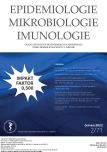Colistin resistance and heteroresistance in Klebsiella pneumoniae & Escherichia coli clinical isolates from intensive care units
Autoři:
M. A. Meheissen 1; S. M. Hendawy 1; F. S. Shabaan 2; A. M. Elmenshawy 3; R. A. Harfoush 1
Působiště autorů:
Medical Microbiology and Immunology Department, Faculty of Medicine, Alexandria University, Egypt
1; Community Department, Faculty of Medicine, Alexandria University, Egypt
2; Critical care Department, Faculty of Medicine, Alexandria University, Egypt
3
Vyšlo v časopise:
Epidemiol. Mikrobiol. Imunol. 71, 2022, č. 2, s. 86-92
Kategorie:
Původní práce
Souhrn
Aim: Colistin resistance poses a serious clinical problem. This study aims to investigate the presence of plasmid-mediated resistance and heteroresistance among Escherichia coli (E. coli) and Klebsiella pneumoniae (K. pneumoniae) clinical isolates at intensive care units of Main Alexandria University Hospital.
Material and Methods: Seventy colistin-resistant and 30 colistin-susceptible K. pneumoniae and E. coli isolates constituted the material of the study. The rapid polymyxin NP (Nordmann Poirel) test was performed. Heteroresistance in colistin-susceptible isolates was investigated by population analysis profile. mcr-1 and mcr-2 genes were amplified by polymerase chain reaction (PCR).
Results: The rapid polymyxin NP test showed 100% concordance with the results of BMD (broth microdilution method). Heteroresistance to colistin was detected in 23.3% of colistin-susceptible K. pneumoniae isolates. All colistin-resistant isolates were negative for mcr-1 and mcr-2 genes.
Conclusions: The rapid polymyxin NP test is a reliable screening tool for colistin resistance, but not for heteroresistance. Other colistin resistance mechanisms should be investigated.
Zdroje
1. Poirel L, Jayol A, Nordmann P. Polymyxins: antibacterial activity, susceptibility testing, and resistance mechanisms encoded by plasmids or chromosomes. Clin Microbiol Rev, 2017; 30(2):557 – 596. doi: 10.1128/CMR.00064-16.
2. Liu Y-Y, Wang Y, Walsh TR, et al. Emergence of plasmid-mediated colistin resistance mechanism MCR-1 in animals and human beings in China: a microbiological and molecular biological study. Lancet Infect Dis, 2016;16 : 161–168. doi:10.1016/S1473 - 3099(15)00424-7.
3. Wang C, Feng Y, Liu L, et al. Identification of novel mobile colistin resistance gene mcr-10. Emerg Microbes Infect, 2020;9(1):508 – 516. doi:10.1080/22221751.2020.1732231.
4. El-Halfawy OM, Valvano MA. Antimicrobial heteroresistance: an emerging field in need of clarity. Clin Microbiol Rev, 2015;28(1):191–207. doi: 10.1128/CMR.00058-14.
5. Magiorakos AP, Srinivasan A, Carey RB, et al. Multidrug-resistant, extensively drug-resistant and pandrug-resistant bacteria: an international expert proposal for interim standard definitions for acquired resistance. Clin Microbiol Infect, 2012;18(3):268 – 281. doi: 10.1111/j.1469-0691.2011.03570.x.
6. Clinical and Laboratory Standards Institute (CLSI). Performance Standards for Antimicrobial Susceptibility Testing. 30th ed. CLSI supplement M100. Wayne, Pennsylvania, USA: Clinical and Laboratory Standards Institute; 2020.
7. The European Committee on Antimicrobial Susceptibility Testing. Breakpoint tables for interpretation of MICs and zone diameters. Version 10.0; 2020. Dostupné na www: http://www. eucast.org.
8. Clinical and Laboratory Standards Institute (CLSI). Methods for dilution antimicrobial susceptibility tests for bacteria that grow aerobically; Approved Standard – Ninth edition. CLSI document M07-A9. Wayne, PA: Clinical and Laboratory Standards Institute; 2012.
9. Nordmann P, Jayol A, Poirel L. Rapid detection of polymyxin resistance in Enterobacteriaceae. Emerg Infect Dis, 2016;22(6):1038 – 1043. doi: 10.3201/eid2206.151840.
10. Meletis G, Tzampaz E, Sianou E, et al. Colistin heteroresistance in carbapenemase-producing Klebsiella pneumoniae. J Antimicrob Chemother, 2011;66(4):946–947. doi: 10.1093/jac/dkr007.
11. Xavier BB, Lammens C, Ruhal R, et al. Identification of a novel plasmid-mediated colistin - resistance gene, mcr-2, in Escherichia coli, Belgium. Euro Surveill, 2016;21(27):30280. doi: 10.2807/1560-7917.ES.2016.21.27.30280.
12. Emara MM, Abd-Elmonsef ME, Abo Elnasr LM, et al. Study of mcr-1 gene-mediated colistin-resistance in Gram-negative isolates in Egypt. Egyp J Med Microbiol, 2019;28(3):9–16.
13. Bakthavatchalam YD, Veeraraghavan B, Mathur P, et al. Polymyxin Nordmann/Poirel test for rapid detection of polymyxin resistance in Enterobacteriaceae: Indian experience. Indian J Med Microbiol, 2016;34(4):564–565. doi: 10.4103/0255-0857.195382.
14. Jayol A, Nordmann P, Lehours P, Poirel L, Dubois V. Comparison of methods for detection of plasmid-mediated and chromosomally encoded colistin resistance in Enterobacteriaceae. Clin Microbiol Infect, 2018;24(2):175–179. doi: 10.1016/j.cmi.2017.06.002.
15. Poudyal A, Howden BP, Bell JM, et al. In vitro pharmacodynamics of colistin against multidrug-resistant Klebsiella pneumoniae. J Antimicrob Chemother, 2008;62 : 1311–1318. doi:10.1093/jac/ dkn425.
16. Band V, Satola SW, Burd EM, et al. Carbapenem-resistant Klebsiella pneumoniae exhibiting clinically undetected colistin heteroresistance leads to treatment failure in a murine model of infection. MBio, 2018;9(2). pii: e02448–17. doi: 10.1128/ mBio.02448-17.
17. Kalaiselvi T. Study of colistin sensitivity among clinical isolates of extensively drug resistant gram negative bacilli. PSG institute of medical sciences and research, peelamedu, coimbatore, tamilnadu, india; 2018. Dostupé na www: www.semanticscholar.org.
18. Prim N, Turbau M, Rivera A, et al. Prevalence of colistin resistance in clinical isolates of Enterobacteriaceae: a four-year crosssectional study. J Infect, 2017;75(6):493–498. doi: 10.1016/j. jinf.2017.09.008.
19. Castanheira M, Griffin MA, Deshpande LM, et al. Detection of mcr-1 among Escherichia coli clinical isolates collected worldwide as part of the SENTRY Antimicrobial Surveillance Program in 2014 and 2015. Antimicrob Agents Chemother, 2016;60 : 5623 – 5624. doi: 10.1128/AAC.01267-16.
Štítky
Hygiena a epidemiologie Infekční lékařství MikrobiologieČlánek vyšel v časopise
Epidemiologie, mikrobiologie, imunologie

2022 Číslo 2
- Stillova choroba: vzácné a závažné systémové onemocnění
- Diagnostika virových hepatitid v kostce – zorientujte se (nejen) v sérologii
- Jak souvisí postcovidový syndrom s poškozením mozku?
- Diagnostický algoritmus při podezření na syndrom periodické horečky
Nejčtenější v tomto čísle
- Candida glabrata – základná charakteristika, virulencia, terapia a rezistencia
- Výskyt tuberkulózy u HIV pozitivních v České republice v letech 2000–2020
- Norovirové infekce v České republice v letech 2008–2020
- Sledování změn invazivních onemocnění způsobených Haemophilus influenzae v České republice v letech 1999–2020
